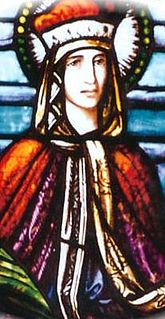
Year 921 (CMXXI) was a common year starting on Monday of the Julian calendar.

The Lakhmids referred to in Arabic as al-Manādhirah (المناذرة) or Banu Lakhm were an Arab kingdom of southern Iraq and East Arabia, with al-Hirah as their capital, from about 300 to 602 AD. They were generally but intermittently the allies and clients of the Sassanian Empire, and participant in the Roman–Persian Wars. While the term "Lakhmids" has also been applied to the ruling dynasty, more recent scholarship prefers to refer to the latter as the Naṣrids.

The Samanid Empire was a Sunni Iranian empire from 819 to 999. The empire was centred in Khorasan and Transoxiana; at its greatest extent encompassing modern-day Tajikistan, Afghanistan, large parts of Iran, Turkmenistan, Uzbekistan, Kyrgyzstan, parts of Kazakhstan and Pakistan.

Abu Kalijar Marzuban, also known as Samsam al-Dawla was the Buyid amir of Iraq (983–987), as well as Fars and Kerman. He was the second son of 'Adud al-Dawla. The Abbasids recognized his succession and conferred upon him the title Samsam al-Dawla. He lacked the qualities of his father 'Adud al-Dawla and failed to have a grip upon his state affairs. His rule was marked by revolts and civil wars.

The Kakuyids were a Shia Muslim dynasty of Daylamite origin that held power in western Persia, Jibal and Persian Iraq. They later became atabegs (governors) of Yazd, Isfahan and Abarkuh from c. 1051 to 1141. They were related to the Buyids.
Zahir al-Dawla Vushmgir, mostly known as Vushmgir, was the second Ziyarid emir who ruled from 935 until his death in December 967. He was a son of Ziyar. Voshmgir means "quail catcher" in the local Caspian Iranian dialects.

Qabus ibn Wushmagir (full name: Abol-Hasan Qābūs ibn Wušmagīr ibn Ziyar Sams al-maʿālī, ابوالحسن قابوس بن وشمگیر بن زیار, شمسالمعالی; was the Ziyarid ruler of Gurgan and Tabaristan in medieval Iran. His father was Vushmgir and his mother was a daughter of the Bavandi Ispahbad Sharwin II.

Nasr ibn Ahmad or Nasr II, nicknamed "the Fortunate", was the ruler (amir) of Transoxiana and Khurasan as the head of the Samanid dynasty from 914 to 943. His reign marked the high point of the Samanid dynasty's fortunes. He was the son of Ahmad ibn Isma’il.

Alid dynasties of northern Iran or Alavids. In the 9th–14th centuries, the northern Iranian regions of Tabaristan, Daylam and Gilan, sandwiched between the Caspian Sea and the Alborz range, came under the rule of a number of Arab Alid dynasties, espousing the Zaydi branch of Shia Islam.

Abū Ḥanīfa al-Nuʿmān ibn Muḥammad ibn Manṣūr ibn Aḥmad ibn Ḥayyūn al-Tamīmiyy (Arabic: النعمان بن محمد بن منصور بن أحمد بن حيون التميمي, generally known as al-Qāḍī al-Nu‘mān or as ibn Ḥayyūn was an Isma'ili jurist and the official historian of the Fatimid Caliphate. He was also called Qaḍi al-Quḍāt "Jurist of the Jurists" and Dāʻī al-Duʻāt "Missionary of Missionaries".
Al-Nuʿmān III ibn al-Mundhir, also transcribed Naʿaman, Nuʿaman and Noman and often known by the patronymic Abu Qabus, was the last Lakhmid king of al-Hirah and a Nestorian Christian Arab. He is considered as one of the most important Lakhmid rulers.
The Daylamites or Dailamites were an Iranian people inhabiting the Daylam—the mountainous regions of northern Iran on the southwest coast of the Caspian Sea, now comprising the southeastern half of Gilan Province.
Azadveh-i Banegan Mahan-i Mihr-Bondad, known in Arabic sources as Azadhbih ibn Baniyan Mahan ibn Mihrbundadh, better simply known as Azadbeh, was an Iranian nobleman, who served as the Sasanian marzban of al-Hira in the period 617-633.
Lili ibn al-Nu'man, also known as Lili ibn Shahdust, was the leader of the Shahanshahvand clan, and also ruled as the second king of the Gilites, ruling from the early 10th-century to 921. He served in high offices under his overlord the Zaydids. In 921, he invaded the territories of Samanids, conquering Damghan, Nishapur and Merv. He was, however, defeated and killed by a Samanid army under Abu'l-Fadl al-Bal'ami and Simjur al-Dawati. Lili was succeeded by Harusindan, who was a Gilite from another clan.
Harusindan was the third king of the Gilites, ruling briefly in 921. He was the son of Tirdadh, who was the first king of the Gilites during the 10th century, but later died and was succeeded by another Gilite named Lili ibn al-Nu'man, who was from another clan. Harusindan also had a sister who married a Dailamite nobleman named Ziyar, and together they had a son named Mardavij, who would later create the Ziyarid dynasty.
Shahanshahvand was the name of a royal Gilite clan roaming in Dakhel, Iran. A member of the clan, Lili ibn al-Nu'man, ruled as the King of the Gilites in the early 10th-century until he was killed in 921 in a battle with the Samanids.
Iyas ibn Qabisah al-Ta'i was governor of al-Hirah, the capital of the Lakhmid kingdom, from 602 to 614CE. He was the son of Qabisah al-Ta'i b. Hani' b. Mas'ud b. 'Amin/'Amir al-Khasib b. 'Amr al-Muzdalif b. AbI Rabi'ah b. Dhuhl b. Shayban b. Tha'labah. He was also the father of Hayyah and Farwah. The last part of Iyas ibn Qabisah's name, al-Ta'i, indicates that he came from the Tayy tribe.
Farawand was the name of a royal Daylamite clan roaming in Dakhel, Iran. A member of the clan, Khushkiya ibn Wijka, ruled as King of the Gilites in the early 10th-century.
Abū ʿAbdallāh Muḥammad ibn Aḥmad Jayhānī, better simply known as Abu Abdallah Jayhani, was the Persian vizier of the Samanid Empire from 914 to 922. His lost geographical work is an important source of 9th-century history of Central Asia and Eastern Europe. His son and grandson also served as viziers.
Nuʿmān ibn Bashīr al-Ansārī was a Companion of the Islamic prophet Muhammad. He was also a commander and statesman of the Umayyad Caliphate. A supporter of Mu'awiya ibn Abi Sufyan during the First Muslim Civil War, he was appointed by him governor of Kufa in 678–680. Afterward, he was made governor of Homs by Caliph Yazid I. After the latter's death, he gave allegiance to the Mecca-based, Caliph Abd Allah ibn al-Zubayr. When pro-Umayyad forces routed Ibn al-Zubayr's supporters in Syria, he fled Homs but was slain during his escape.








